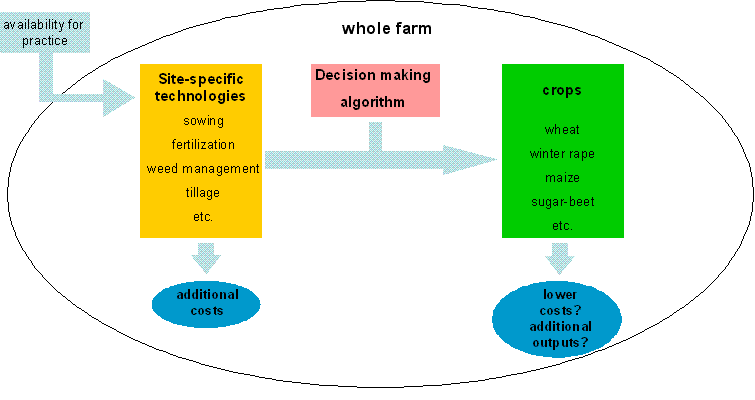
Sub-Project (TP) 3
Project realization: Martin-Luther-University Halle, Institute of Agricultural Economics, Farm Management Group
TP Title: Economic evaluation of Precision Agriculture in a farm-wide context
TP Subtitle: Economic viability
TP-Goal: Assessments of economic viability of farms using Precision Agriculture will be made considering conditions of different crops, organisation structures, Precision Agriculture equipment and farm sizes.
Position of the TP in the entire Project: Cross-section project over all project areas
There exist many potential strategies for Precision Agriculture. Site specific applications of sowing, fertilization, weed management, tillage and irrigation are possible. Each farmer has to choose a suitable combination for his conditions. As a result, the following questions arise: How, and using which criteria, such a choice should be made? What increase in economic potential can be expected through the use of Precision Agriculture technologies on a farm? In addition, which useful effects for a farm can be expected through these technologies, which canít be evaluated financially in a direct way?
The following diagram shows the potential effects of Precision Agriculture for a farm:

On farm application of Precision Agriculture technology causes additional costs. The expected benefits lie in a possible reduction of input costs and additional outputs (e.g. yield- or quality increase).
Expected results of the sub-project:
1. statements about the economics of Precision Agriculture under different conditions
2. statements about the economics of Precision Agriculture for model farms in different regions
3. statements about potential risk reduction through the adoption of Precision Agriculture technologies
4. statements about non-financial benefits resulting from Precision Agriculture
The economic effects of Precision Agriculture will be evaluated from a whole farm perspective. Profitability thresholds (e.g. farm sizes) will be calculated on the basis of break-even analyses. At the base of on farm experiments, which will be carried out at the preagro experimental farms (Saxony-Anhalt and Lower Saxony), whole farm effects will be calculated. In addition to that, the business-management risk-reduction potential of Precision Agriculture will be examined. For example, the annual varying yields are a risk factor for farms. Additional, non monetary outputs, caused by site-specific management, will be defined and characterized. An example of these would be automated data collection, e.g. for the documentation of production processes.
Methodology for an economic evaluation of Precision Agriculture
All of the different costs and outputs affected by Precision Agriculture have to be taken into account for an evaluation. Only the additional cost and output values are interesting. The question is, whether the additional outputs are greater than the additional costs. The different strategies can be compared and the potentials can be calculated. Additional outputs are, for example, increases in yield or quality and savings in means of production. Additional costs result from extra investments in information generation, information management, Precision Agriculture techniques and means of production. The strategy comparisons will be calculated on a yearly basis.
Useful literature:
∑ Lambert, D. and Lowenberg-DeBoer, J. (2000): Precision Agriculture Profitability Review (Summary of 108 different economic evaluations of Precision Agriculture)
Last update 2005-04-21